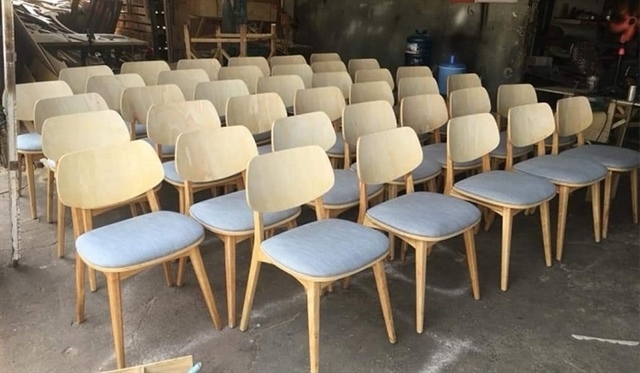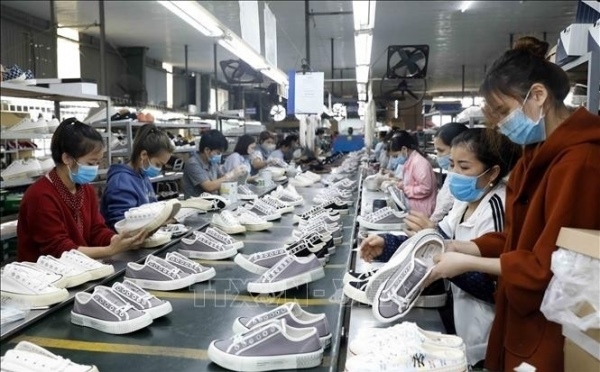Collaborations required to achieve wood industry goals
Collaborations required to achieve wood industry goals
As the Ministry of Agriculture and Rural Development has set forth an ambitious target for 2021 after the poor results from last year, experts from wood and timber associations are calling for more cooperation between foreign-invested and domestic enterprises in the industry, backed by preferential policy mechanisms that enable close cooperation.

With foreign investment a core part of the wood industry, all stakeholders stand to benefit from extended cooperation. Photo: Le Toan
|
Chinese companies have been using Vietnam as a transit port leading to soaring export turnovers, so much so that it has caused suspicion among international partners, especially the US. The issue has attracted more attention as US Customs recently discovered that Finewood Vietnam Co., Ltd. imported plywood from China, brought it back to the factory to change the label to a Vietnamese one, and then exported it to the United States.
Along with that, the enterprise also allegedly acted as a forged address issued in Vietnam, even though the goods are not imported into the nation nor have they been exported out of its territory.
Amid the ongoing US-China trade war, Vietnam has new opportunities for foreign direct investment (FDI) in Vietnam’s wood industry, including the recent expansion in the number and export value of foreign-invested enterprises (FIEs) here.
Data from Forest Trends and some wood associations shows that by the end of 2020, the wood industry has received 63 new projects with the total registered capital of nearly $327.7 million, as well as an increase in total additional capital of $193.6 million, while share purchases within the sector reached a volume of $244.8 million. Although these numbers are all lower than the 2019 figures, last year’s figures reaffirm the industry’s attractiveness in FDI activities.
Damaged wood industry
In Vietnam, the increase in such activities within the industry is partly the result of next-generation free trade agreements and the country’s favourable geographic location in the Asia-Pacific economic region. The industry’s FDI increase is also a direct result of the government’s preferential policies and investment attraction programmes in recent years.
Vietnam has more than 3,600 enterprises directly involved in exporting wood and products thereof, reaching an export value of $12.31 billion in 2020. Of which, 653 FIEs are directly involved in exporting, accounting for 18 per cent of the total number of exporters, with a turnover of $6 billion, accounting for 51 per cent of the total export turnover of the industry.
Compared with the 2,676 domestic enterprises and their $5.9 billion in export turnover, FIEs outperformed these in terms of export scale. This superiority can be attributed to the differences in the production scale, technology application, and management skills, as well as the used investment capital and market access of FIEs. However, to date no reviews or studies have been looking more in-depth at these aspects.
FDI remains an inseparable part of the wood industry, although some related activities carry huge risks that have been hurting the industry. Recognising the seriousness of under-investment and shadow investments, Vietnam’s authorities have been working hard to control the situation and introduce risk reduction measures.
The Ministry of Planning and Investment (MPI) in February sent a document to municipal and provincial people’s committees to call for stricter control of anti-origin fraud actions against wood products.
The MPI also requested local authorities to inspect foreign-invested projects to reduce the risk of origin fraud and prioritise the selection of projects with superior technology, while consulting with timber associations about investment projects and carefully considering investment projects with fraud risk factors.
However, effective implementation of this call requires localities to pay due attention to FDI activities in their administration, including establishing inspection and monitoring mechanisms with the participation of related stakeholders.
The Ministry of Agriculture and Rural Development set a target for the wood industry, with the export value of forest products expected to be $14-14.5 billion by the end of 2021, up about 9.6 per cent on-year.
Cao Cam, an analyst of the Vietnam Timber and Forest Product Association, found that the signals from the US market up to this point were clear. The Office of the US Trade Representative is investigating the Vietnamese wood industry following regulations, based in part on the allegation that underground investments are taking place in the wood industry to enjoy import tax benefits from the US.
“Such fluctuations from the US market will have an impact on the entire wood industry, affecting the industry’s goals,” Cam said.
Currently, the US is the most important export market for Vietnam’s wood industry, with its share within the total export turnover to this market in 2020 reaching well over 60 per cent.
|
Foreign direct investment in the Vietnamese wood industry Influenced by COVID-19, by 2020, foreign-invested projects in the wood industry decreased in both quantity and capital in all new forms, including capital increase, capital contribution, and share purchase. The industry received 63 new projects capitalised $372.7 million, down 36 per cent in the number of projects and 49 per cent in capital compared to 2019. In terms of capital contribution and share purchases, in 2020 there were 122 capital contributions and share purchases from foreign enterprises, with capital contributions amounting to $244.80 million, a decrease of 57 per cent in quantity and 23 per cent in capital compared to 2019. Also last year, foreign-invested projects saw 52 capital increases, with a total capital rise of $193.64 million and an increase of 73 per cent in quantity but a drop of 3 per cent in capital compared to the previous year. |
Policy aspects
Meanwhile, in 2021 the wood industry is predicted to continue to be an attractive destination for foreign investment. FDI inflows mainly from Asian markets such as China, Taiwan, Hong Kong, and Singapore focus on the southeastern provinces. The average investment per project is small and investments focus on wood products like furniture such as beds, wardrobes, and kitchen cabinets, as well as plywood.
Dr. To Xuan Phuc, an expert at Forest Trends, said that the cooperation between national associations, domestic enterprises, and FIEs is “vital to effectively carry out the supervision to eliminate risks of under- and shadow investments in the industry.”
According to Phuc, the superiority of FIEs in Vietnam should also be summed up and utilised to create spillover effects in the industry. In his opinion, the wood industry should call for studies to examine the factors that make up the dominance of FIEs and create a mechanism for these factors to spread to the whole industry.
Phuc also mentioned that pervasiveness requires a “suitable mechanism and policy environment, that allows for the exchange of information and experiences between FIEs and domestic enterprises.” Thus, the current policy mechanism for the industry would need to change. He also said that it is important “to allow FIEs to become official members of associations, creating opportunities for them to comment on the industry’s development.”
Phuc believed that Vietnam’s wood industry will develop sustainably if both sides are acting as a unified entity through new mechanisms and policies that will contribute to spill-over effects. Besides this, such a unified entity would also contribute to positioning and minimising risks in FDI activities.
Nguyen Chanh Phuong, vice chairman of the Handicraft and Wood Industry Association commented that in 2021, the mentioned risks will affect the whole wood industry. “Meanwhile, the industry’s significance with around $14 billion exported goods and jobs for half a million workers cannot be ignored,” he said.
“If the wood industry has many stakeholders, it will be stronger. However, there is a possibility that money flows to both sides – the investors and Vietnam,” Phuong said.




























